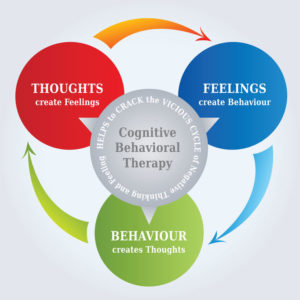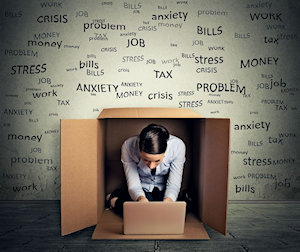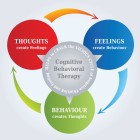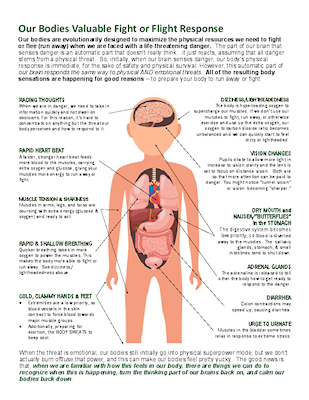Tag Archives:cornerstone
Illustration of (Some) CBT Concepts share
 Overview
Overview
Cognitive Behavioral Therapy (CBT) is the strongest, research-backed therapeutic approach in the treatment of anxiety and, additionally, to be very effective for a whole host of other mental health issues. It is based on the framework that emotions, thoughts, and body sensations/physical behavior are at three points of a triangle and intervening on one of the points will result in changes the other two.
TEDx Talk: Feeling Good presented by David Burns, MD – In this YouTube video, David Burns, MD, a well known researcher, clinician, and educator introduces the power of CBT in his warm, humorous and down-to-earth way.
Concepts
“Automatic Thoughts”
Automatic thoughts are a core concept of CBT. They are our brain’s running interior dialogue or self-talk that narrates our life without us even really being aware of that it’s happening until we choose to pay attention to them. If your thoughts frequently contain “thought errors” that are biased to being negative ones, they are very likely to be increasing the level of anxiety or depression that you feel necessarily . These thoughts are habits that reflect the way we interpret things that we do, experience, or even how we view the world. The thing about habits is that, with some work, they can be shifted or changed. When you increase awareness of what your automatic thoughts are, you can start to challenge them and then, ultimately, reduce their effect on your perceptions and your mood. When working with children, negative automatic thoughts that affect them this can sometimes be referred to as a “brain bully.”
- An animated video that talks about automatic thoughts and gives an overview of some of the typical “thought errors” that people might have. Read More >
Thought Errors/Cognitive Distortions
“Focus on the Negative”
Focusing on the negative is known in CBT as a cognitive distortion or “thought error” that can increase the level of anxiety or depression that you feel. The human brain is drawn to negatives but it skews our perception of people and the world around us. With the easy access to negativity in the media, including the internet, it can be more and more challenging to pull our minds away and, instead, choose to focus on the wealth of positive things in our lives. However, the research shows that with practice we can get better at recognizing when we are focusing on only the negative aspects of something and then consciously remind ourselves of all of the positives in the situation instead.
- A playful animated video that illustrates this idea. Read More >
- TED talk that gives a more scientific explanation of how our brains seem to stay stuck on negative information, and how to get unstuck. Read More >
- Story time! At least that’s what our brain is doing when we are experiencing fear for something that might happen in the future. Check out this TED talk and learn more. Hmmm…why might this knowledge be important? Read More >
Panic Attacks Part 1: What is Panic & Why We Need It share
Panic is a normal, necessary physical response to the brain perceiving a significant threat. It involves the release of a hormone that you are likely familiar with, adrenaline. Adrenaline’s job is to tell the body to make chemical changes in the body so that the body is physically primed to either fight or flee/run away, from the threat. These can be things such as:
- Rapid heartbeat
- Short, shallow breaths
- Paling or flushing (can switch between both)
- Digestion slows down or stops (becomes a low priority for your body)
- Constriction of blood vessels in many parts of the body…including the BRAIN (which interferes with your ability to think logically)
- Dilation of blood vessels for muscles (so they are ready for action)
- Take energy from stored nutrients to fuel muscles
- Dilation of pupils
- Temporary loss of hearing
- Tunnel vision (loss of peripheral vision)
- Physical shaking

Back in the day of the caveman, the people who didn’t have a panic response were much less likely to survive because their bodies were not as prepared to deal with a physical threat. Our body’s ability to quickly maximize all of our resources for survival is a critical aspect not only of humans but all animal species. Yet, in our Western culture, many of us are fortunate that our safety is not regularly threatened in a physical way. Instead, because our brain does not recognize a difference between a physical threat and emotional threat, in a modern society a panic response can often be triggered by things such as fear of embarrassment or fear that a bridge might collapse. Or, perhaps you do have experience with your physical safety being at risk and now, your body is in hyper-vigilant mode and looking for danger at every corner.
The problem here is that our body’s physical readiness to fight or run won’t help us to not be embarrassed. Nor will it help us cross a perfectly well-maintained bridge or walk around the corner in a typically safe neighborhood. Instead, that physical response can feel scary itself and physically uncomfortable if we don’t do anything to burn off that energy and bring our body back to calm. Additionally, increasing our breathing rate without making use of the extra oxygen we are taking in creates a chemical imbalance between the oxygen and carbon dioxide levels of our body that adds to our feelings of physical discomfort.
So, what can we do if we start to physically panic about a possible emotional threat? Check out the next article in this series!
Remaining articles in this series:
- Panic Attacks Part 2: The Antidote to Panic – Relaxation Breathing
- Panic Attacks Part 3: Fear of the Fear – Don’t Let Panic Attacks Take Over Your Life
- Panic Attacks Part 4: Time To Tune Into Your Early Warning System (coming soon)
Anxiety & Depression share
 Anxiety and depression affect a significant portion of our population: 18.1% of US adults had some form of excessive anxiety within a 12 month period in 2005 and 9.5% have some form of mood disorder.1 The numbers for a US adult having either of these two issues at some point within their lifetime is even higher: anxiety disorders, 28.8%; mood disorders, 20.8%.2 Genetics, how we were raised, poor nutrition/eating habits, lack of physical exercise, not enough sleep, use of drugs and alcohol, and life events can all play a role in why someone might struggle with anxiety and/or depression.
Anxiety and depression affect a significant portion of our population: 18.1% of US adults had some form of excessive anxiety within a 12 month period in 2005 and 9.5% have some form of mood disorder.1 The numbers for a US adult having either of these two issues at some point within their lifetime is even higher: anxiety disorders, 28.8%; mood disorders, 20.8%.2 Genetics, how we were raised, poor nutrition/eating habits, lack of physical exercise, not enough sleep, use of drugs and alcohol, and life events can all play a role in why someone might struggle with anxiety and/or depression.
Trying to eat three well-balanced, healthy meals (that include adequate protein and complex carbohydrates), getting adequate sleep (minimum 6-7 hours/night), regularly exercising (even if it’s just a 10 minute walk up the street and back), and avoiding use of drugs and alcohol can go a long way in helping to reduce the intense emotions you may be struggling with. Additionally, Cognitive Behavioral Therapy, and an newer off-shoot of it, Dialectal Behavioral Therapy, are two forms of therapy that scientific research shows to be quite effective in treating both anxiety and depression. (And, if there is underlying trauma that fuels the anxiety and/or depression, other types of therapy like EMDR, Brainspotting, Somatic Therapy, and Developmental Needs Meeting Strategy (DNMS) can really go a long way with helping the body come back to being able to feel safe and secure and significantly reliving the depression and anxiety symptoms.)
As this site continues to grow, you will find resources to help you better understand some of the struggles you are going through, to help you realize that you aren’t alone, and to find ideas about how you can move forward through the more challenging times in your life while reaching out to others friends and family (and/or therapist if you need) for support. Be sure to check out the How to Use This Site page to get you familiar with how resources are organized on the site. For those of you who would rather just jump in without an instruction manual, you can either search for key terms or move your mouse over Resource Index by Topic in the top menu bar and jump right in! The best place to start for issues based in anxiety or depression would be the Anxiety & Depression Index.
Sources:
1 Kessler Ronald C., et al. Prevalence, severity, and comorbidity of twelve-month DSM-IV disorders in the National Comorbidity Survey Replication (NCS-R). Archives of General Psychiatry, 2005 Jun;62(6):617-27.
2 Kessler, Ronald C., et al. “Lifetime prevalence and age-of-onset distributions of DSM-IV disorders in the National Comorbidity Survey Replication.” Archives of general psychiatry 62.6 (2005): 593-602
Emotionally Intelligent Life Skills share
 There are several types of skills that are worth working on because, as we all get better at them, they help us have less conflict and difficulty in our lives and increase the possibility that other people understand our thoughts and feelings. And the more often that happens, the more likely we are to experience our day to day life as happy. For example, Executive Functioning Skills help us to be organized so that we take care of the things we need to and help us to feel more responsible and in control of our lives. Mindfulness Skills help us to find pleasures in the small moments in life that are happening around us all of the time. They help us worry less and be happy more. Relaxation Skills, mindfulness being one of them, help us to calm anger and reduce panic and worry. Social Skills help us to work well in groups, create/deepen/maintain friendships and loving relationships, and increase the chances of other people having good/comfortable thoughts about us. Anger Management and Conflict Resolution Skills help us to not let our emotions create bigger problems for us than we already have and help us to solve problems in ways that encourage people to have good/comfortable thoughts about us.
There are several types of skills that are worth working on because, as we all get better at them, they help us have less conflict and difficulty in our lives and increase the possibility that other people understand our thoughts and feelings. And the more often that happens, the more likely we are to experience our day to day life as happy. For example, Executive Functioning Skills help us to be organized so that we take care of the things we need to and help us to feel more responsible and in control of our lives. Mindfulness Skills help us to find pleasures in the small moments in life that are happening around us all of the time. They help us worry less and be happy more. Relaxation Skills, mindfulness being one of them, help us to calm anger and reduce panic and worry. Social Skills help us to work well in groups, create/deepen/maintain friendships and loving relationships, and increase the chances of other people having good/comfortable thoughts about us. Anger Management and Conflict Resolution Skills help us to not let our emotions create bigger problems for us than we already have and help us to solve problems in ways that encourage people to have good/comfortable thoughts about us.
These are all skills that we start to learn as kids but that we continue to hone as adults. And, just like working out makes your muscles strong and makes it easier to do physical things , the more we practice these valuable life skills the stronger our life skills become and the easier it is to positively manage emotional things. Study after study shows that creating habits by practicing something over and over again reinforces neural pathways in our brains and results in “habits.” This means that the more we practice and flex our emotional muscles, the easier these skills become for us. So get out there and learn some new skills or just keep practicing the ones that you have already learned about. It pays off!!
Life Stressors share
 Life stress can test and strain our normal coping skills. Sometimes the stress comes from normal life events like the loss of a parent, getting married, or changing jobs. Other times, the stress can come from the conflict we feel between living our lives by expressing the “true selves” we feel in our hearts and our fears that we will not be accepted by others for who we are. Chronic pain, the shadow of emotional trauma from past abuse, pressures that come from our complicated, modern lives…it all can get to be overwhelming.
Life stress can test and strain our normal coping skills. Sometimes the stress comes from normal life events like the loss of a parent, getting married, or changing jobs. Other times, the stress can come from the conflict we feel between living our lives by expressing the “true selves” we feel in our hearts and our fears that we will not be accepted by others for who we are. Chronic pain, the shadow of emotional trauma from past abuse, pressures that come from our complicated, modern lives…it all can get to be overwhelming.
As this site grows, you will find resources to help you better understand some of the struggles you are going through, to not feel so alone, and ideas for how you can move forward through the more challenging times in your life while reaching out to others, friends, and family (and/or therapist if you need) for support. Be sure to check out the How to Use This Site page to get you familiar with how resources are organized on the site. For those of you who would rather just jump in without an instruction manual, you can either search for key terms or move your mouse over Resource Index by Topic in the top menu bar and jump right in!






